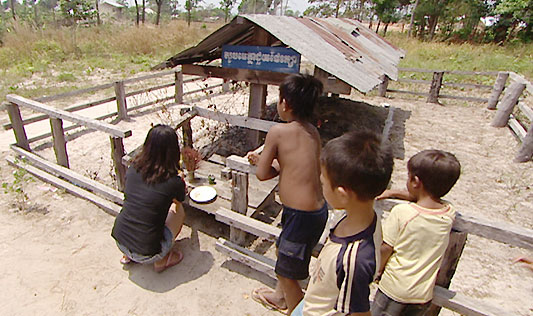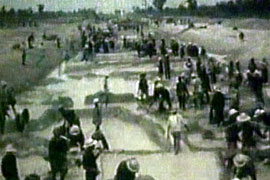The legacy of Year Zero
More than three decades on, Cambodia has yet to come to terms with the Khmer Rouge.

 |
| Many young Cambodians are unaware of the extent of their country’s brutal past |
In a dusty corner of Cambodia a young woman pays her respects at the grave of a dead villager.
Oeurni Vi has come to give thanks after her prayer to see a boyfriend again was granted.
She comes to the grave, she says, because she loves and trusts the man who was cremated here. She even wishes he could come back.
Yet the man she so reveres was once the leader of one of the 20th century’s most brutal regimes – responsible for the death of almost a quarter of Cambodia’s population.
 |
| Oeurni Vi says she wishes Pol Pot could come back |
His name was Pol Pot, former leader of the notorious Khmer Rouge.
The town of Anlong Veng, close to the border with Thailand, was once the movement’s de facto capital after it had been ousted from power by the Vietnamese.
Today it is a town on the move, building new roads and changing its image.
In the village primary school, children learn the Khmer alphabet, but the bloody history of the Khmer Rouge is not formally taught in Cambodia‘s schools.
Few of the pupils have even heard of Pol Pot, let alone the acts committed under his rule.
It is now more than 30 years since the Maoist regime swept to power, clearing Cambodia‘s towns to build an agrarian utopia as they turned the clocks back and declared the start of “Year Zero”.
Their reign between 1975 and 1979 caused the deaths of as many as 2 million Cambodians, many worked to death in what have became known as the “Killing Fields”.
| Cambodia: After the killing fields | ||||
|
|
Pol Pot and the Khmer Rouge are now consigned to history, but a handful of other leaders are still alive and more than three decades later their day it seems in court is nearing.
Cambodian and foreign lawyers have finally agreed on the rules to be followed in putting the former leaders of the Khmer Rouge on trial.
It has been a long and tortuous process that has literally required a rewriting of the rulebook.
Until recently Cambodia did not even have a law dealing with genocide.
San Roeurng is a former Khmer Rouge soldier who lost one of his leg’s fighting for the cause.
Evidence
 |
| Up to two million Cambodians died in what have become known as the ‘killing fields’ |
While he venerates his former leaders, he concedes the trials are necessary for the good of the country.
“If people show me the evidence that proves they are guilty then the Cambodian people will be happy and I will be happy,” he says.
But, he says, he is worried that the trial will not be just.
And worry he might. The lead up to the hearings has been dogged by accusations of political interference and grandstanding that has set the process back for years.
The delay has already seen one of the tribunal’s likely top defendants slip through the net.
Ta Mok – the Khmer Rouge military commander whose brutal reputation earned him the nickname “The Butcher” – died last year in custody, effectively avoiding justice.
Even now, the first hearings at the tribunal, formally known as the Extraordinary Chambers in the Courts of Cambodia (ECCC), are not expected before early 2008.
The ECCC denies there has been any foot dragging and says it is as frustrated as anyone by the delays.
Time running out
 |
| The first hearings are not expected to begin until at least early 2008 |
But even those helping preparations for the trial admit time is not on their side.
Helen Jarvis, the tribunal’s head of public affairs, says that Cambodia‘s resolution with its unique and troubled past is at stake.
“If the defendants were to pass away before indictments came down or during the trials that would be a great loss,” she says.
When they finally convene the hearings will take place in a converted army barracks outside Phnom Penh, the Cambodian capital.
There is no jury, but a bench of judges made up of three Cambodian and two international judges.
In the supreme court, which will hear appeals, there will be four local and three international judges.
If they cannot come to a unanimous decision then there must be a “super majority” – meaning there must be agreement from at least one person from each side
For many, like Youk Chnang, the head of the Cambodian Genocide Documentation Centre, the tribunal will mark the culmination of years of work.
For Cambodia to move on and face the future, it must, he says, first face up to its past.
“It’s beyond justice, its human history and that’s important for us to understand.”
